
by Olga Mecking | Feb 3, 2014 | 2014, Awareness, Being Thankful, Bilingual, Culture, Education, Expat Life, Humanitarian, Inspirational, Language, Life Lesson, Living Abroad, Millennium Development Goals, Motherhood, Moving, Netherlands, Philanthropy, Shot@Life, Social Good, Stress, World Motherhood
 Until a friend of mine had a terrible tragic accident in the Himalaya mountains that left her in a coma, I had never donated to a charity. We collected some money at our wedding to give to her husband, and my mom also donated some money to a charity that takes care of her, but that was it.
Until a friend of mine had a terrible tragic accident in the Himalaya mountains that left her in a coma, I had never donated to a charity. We collected some money at our wedding to give to her husband, and my mom also donated some money to a charity that takes care of her, but that was it.
Since moving to another country and having children, I have been looking for ways to help others. I want to donate to more charities. I am just looking for the right one.
It isn’t easy. I have heard of many charities that have turned out to be scams or which just took people’s money and ran.
My situation is especially difficult because I live in a foreign country and do not know about the charities here. Though my Dutch is fluent, I still have trouble communicating in this language sometimes. In the Netherlands, many people go house-to-house collecting money for charities.
I think it is interesting to find out about charities that way because they’re often ones I’ve never heard of before. They are often small scale actions rather than big ones. But I think the mistake they’re making is the following one: before I contribute, I’d like to find out more about the organization, whether my friends have heard of it, whether there is something about them that raises red flags.
I think I might even agree to donate money if they were willing to leave a business card or something I could find them by. Instead, they want me to make a monthly commitment. Again, because I do not know them, I am not so keen on giving them my credit card number.
At the same time, my heart breaks for all the little children going through invasive treatments; who are terminally ill; who look like little ghosts because they have lost so much weight from all their chemo; for all the sick people who can’t get the treatment they need; or for children who are not so fortunate as mine; or moms in poorer countries, who have to travel for many days if they want to give birth in a hospital.
I really want to help. Since I became a mom and later a World Moms Blog contributor, I have been made aware of needs and dreams that can’t be fulfilled because of the bad conditions all around the world.
But the fact is that finding the right charity isn’t easy. I mostly say no to these door-to-door people. I do it with a heavy heart. I just want to make sure that I am really helping people in need, and not wasting my money.
Luckily, while looking for a charity to donate to, there is a lot I can do:
- In my circle of friends alone, there have been situations where help was needed, including domestic violence and pregnancy problems.
- I am considering taking the Shot@Life pledge and becoming a Champion.
- I can learn as much as I can about actions such as #MDG’s and participate in our Twitter Parties.
- I can find local communities, organizations, charities and brands.
- Many of my friends are absolutely talented people and use their talents to collect money for a good cause, and I can help them spread the word and participate.
I know this sounds like nothing, and I am not telling this to show off how good of a person I am. It is just to show that even though it sounds like nothing, we all can make a difference. I am still very new at this social good cause. I still have a lot to learn. Already I have asked my fellow World Moms Blog contributors for help choosing a charity I can actually trust and they have come up with great charities.
I need to do more. I want to do more. I will do more.
Do you have a charity or cause worth supporting? Tell us about it and help spread the word
This is an original post to World Moms Blog from Olga Mecking in The Netherlands.
The image used in this post is credited to Images Money. It holds a Flickr Creative Commons attribution license.
Olga is a Polish woman living in the Netherlands with her German husband. She is a multilingual expat mom to three trilingual children (even though, theoretically, only one is trilingual since she's old enough to speak). She loves being an expat, exploring new cultures, learning languages, cooking and raising her children. Occasionally, Olga gives trainings in intercultural communication and works as a translator. Otherwise, you can find her sharing her experiences on her blog, The European Mama. Also take a while to visit her Facebook page .
More Posts - Website
Follow Me:




by Melanie Oda (Japan) | Jan 30, 2014 | Childhood, Japan, Preschool, Younger Children
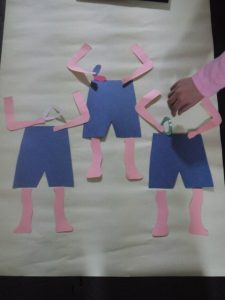
A Work in Progress
One of the first things I noticed when I moved to Japan, standing as I did in many a cold gym on a drafty stage being stared at by bored students, is that in Japan even small changes are deemed deserving of a ceremony of some sort. I worked as an assistant language teacher dispatched by the board of education to seven different junior high schools. On my first day at each and every one of those schools, an assembly was held to welcome me. The principal gave a little speech. I gave a little speech. The head English teacher and a student representative gave a little speech, too.
On my last day, a very similar ceremony was held. Except that this time I got flowers. Seven bouquets of flowers and me trying to leave town…. I tried at other jobs, when other coworkers were leaving, to explain that these giant bouquets, while beautiful, were actually not desirable for someone who was (more often than not) preparing to leave the country.
“The flowers,” I was told, “Are not for the person leaving. They are for the people staying behind.”
Now that I’m a mom, I’ve noticed that Japanese school children’s lives are chock-full of ceremonies. It starts with preschool, when they have an entrance ceremony. Then a closing-of-first-term ceremony, an opening-of-second-term ceremony, then closing-of-second-term ceremony. It seems endless. But for the preschooler, it culminates in graduation and the send-off to end all send-offs, the “Wakare-kai,” a kind of Sayonara Party.
Now I don’t know about where you are from, but I have no memory whatsoever of having a preschool graduation, much less an after party. My parents may have privately celebrated my ascension into free (!) public schooling after I’d gone to bed at night, but I don’t think there was much to it.
Here?
(Hold on a second while I get a cold compress for my splitting headache….)
At my daughter’s preschool, it’s a huge deal. And it’s all put on by the moms. I don’t think this experience is rare for a Japanese preschool, but to me it feels totally over the top.
It starts off in October (a full six months before The Day), with each mother being assigned to a committee. And I do mean everyone, including, for example, my friend who has three kids under six and another on the way. There are a host of different committees, the lunch committee, the keeping-children-in-line committee, the video committee, the slide show committee, the teacher’s present committee, etc. I’m on the decoration committee.
It seems like it would be simple enough. Maybe some paper chains and balloons? But no. There will be a balloon archway for the teachers to walk through. We will decorate the back wall with scenes (we have to draw) of the momentous events that have transpired in our 6-year-olds lives at preschool. (I’m in charge of drawing a poster for sports day and the yearly school play.) There will be a podium decorated with paper mâché animals, mobiles hanging from the ceilings (no clue how we are supposed to get those up there,) flowers and tinsel on the walls, etc., etc., etc.
I’ve already spent hours in meetings that I feel we’re pretty pointless, not to mention hours on actual decorations, and I’m sure there will be an hour or two on the day for decorating and cleaning up.
I’m having a hard time thinking of any of this as being more than wasted time. But I have to wonder if, like the flowers being given to the leaving teacher, the send-off party is not actually for the children at all.
What kind of ceremonies are held at schools in your country? To what extent are parents involved?
This is an original post by World Moms Blog contributor, Melanie Oda in Japan, of Hamakko Mommy.
Photo credit to the author.
If you ask Melanie Oda where she is from, she will answer "Georgia." (Unless you ask her in Japanese. Then she will say "America.") It sounds nice, and it's a one-word answer, which is what most people expect. The truth is more complex. She moved around several small towns in the south growing up. Such is life when your father is a Southern Baptist preacher of the hellfire and brimstone variety.
She came to Japan in 2000 as an assistant language teacher, and has never managed to leave. She currently resides in Yokohama, on the outskirts of Tokyo (but please don't tell anyone she described it that way! Citizens of Yokohama have a lot of pride). No one is more surprised to find her here, married to a Japanese man and with two bilingual children (aged four and seven), than herself. And possibly her mother.
You can read more about her misadventures in Asia on her blog, HamakkoMommy.
More Posts
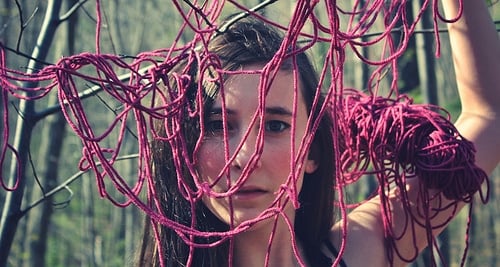
by Ecoziva (Brazil) | Jan 20, 2014 | 2014, Being Thankful, Brazil, Childhood, Education, Family, Inspirational, Kids, Life Lesson, Maternal Health, Motherhood, Parenting, Relationships, Womanhood, Working Mother, World Motherhood
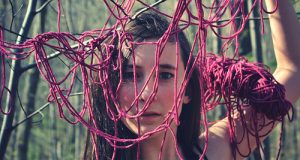 You know how someone can tell you something that you already knew but in just such a way that finally something “clicks” inside you?
You know how someone can tell you something that you already knew but in just such a way that finally something “clicks” inside you?
That is what I felt when I read Argentinean psychotherapist, Laura Gutman’s, work recently. Laura Gutman’s books are best-sellers in several Spanish speaking nations, where she is known for promoting conscious mothering.
Three of her books have been translated into Portuguese, of which one has also been published in English. I had heard so many good reviews of this particular one (Maternity, coming to face with our own shadow) that I bought it as a Christmas gift for a friend, who is planning on getting pregnant soon. For another friend, I bought a second one, whose title seemed interesting – it could be roughly translated as The power of maternal discourse.
I confess that – after three kids (including a baby), having read tons of parenting books and with restricted time for reading anything unrelated to work – I didn’t plan on tackling either anytime soon. I didn’t really think there would be anything new. However, when I picked up The power of maternal discourse I couldn’t stop. And immediately after I finished I read Maternity...
Yes, a lot of it was not new to me and some parts I did not fully agree with. Yet, overall the way she said it (and all of the case studies she used as examples) made such a difference that it produced somewhat of a revolution in my life, especially in three areas: my relationship with my mother, my relationship with myself and my relationship with my children. In this part I would like to talk about how it affected my relationship with my mother.
For starters, my relationship with my mother wasn’t exactly affected in a positive way, at least not in practice. In fact, we had a huge fight right after I read the book which ended up in us not spending Christmas together. Yet, although unpleasant, it was necessary as we both said things that had been kept inside for years.
One of the main arguments of The power… is that our own personal story is mostly constructed by what the dominant adult in our childhood (usually our mother) said, which is not necessarily accurate or entirely true. Thus, Gutman states, the unsaid truths are often what hold us back, producing our so-called “shadow”.
For those of you unfamiliar with the concept of shadow, it would be our unfaced “dark side”, a side we try to suppress or deny, often at high cost. Additionally, as other authors have argued, we must try to understand, accept and learn from our shadow, and one way to do that would be by trying to reconstruct and examine our true life story.
The power… is not an optimistic book. In fact, from her decades as a therapist, the author believes most people’s lives have been tainted by some sort of childhood abuse. Of course her definition of abuse is ample, yet the examples she brings are quite distressing.
I guess what resonated most with me were her writings on “childish mothers”. More specifically, how many mothers – despite providing adequate physical care for their children and apparently being present – are often emotionally absent and overly self-involved, which results in the child carrying out the mother’s role in many situations. Then, when this child becomes a mother (or a father) the unresolved child within them will make them act childish and emotionally unavailable with their own child(ren) and so on.
Although her ideas were not exactly new, as I said, for some reason many things finally clicked. When adults we all know are parents are flawed and we might even understand and forgive these flaws, yet in practice these flaws may still be hard to deal with. Although we may rationally believe that our mother/father did the best they could to raise us, with the tools and knowledge they had at that moment in their lives – the hurt child in us might still dominate our emotions in practice.
In my case, many things I carried around as being my “fault” were really my mother’s responsibility, and that was surprisingly hard to admit and accept.
On the other hand, Gutman encourages us to step into the adult we are now and make our own choices by understanding and accepting the truth about our past. And hopefully engaging in a better relationship with ourselves and with our own children, which is what I am trying to do now!
And you? How have you dealt with issues related to your own parents? How has resolving (or not) these issues helped you in your relationship with your children?
This is an original post to World Moms Blog from our writer in Brazil and mother of three, EcoZiva.
The image used in this post is credited to photographer martinak15. It holds a Flickr Creative Commons attribution license.
Eco, from the greek oikos means home; Ziva has many meanings and roots, including Hebrew (brilliance, light), Slovenian (goddess of life) and Sanskrit (blessing). In Brazil, where EcoZiva has lived for most of her life, giving birth is often termed “giving the light”; thus, she thought, a mother is “home to light” during the nine months of pregnancy, and so the penname EcoZiva came to be for World Moms Blog.
Born in the USA in a multi-ethnic extended family, EcoZiva is married and the mother of two boys (aged 12 and three) and a five-year-old girl and a three yearboy. She is trained as a biologist and presently an university researcher/professor, but also a volunteer at the local environmental movement.
More Posts

by Sophie Walker (UK) | Dec 11, 2013 | 2013, Autism, Being Thankful, Childhood, Divorce, Education, Friendship, Girls, Inspirational, Kids, Life Balance, Life Lesson, Me-Time, Older Children, Parenting, Relationships, Running, School, Sophie Walker, Special Needs, Stress, UK, Womanhood, Working Mother, World Motherhood, Writing
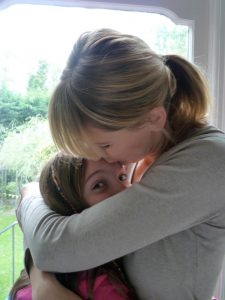 When I was a little girl, I wanted to be a writer.
When I was a little girl, I wanted to be a writer.
My bookshelves were bursting with myths and legends, tales of epic journeys and magical enchantments and warriors and warlocks and princesses; talking animals and terrifying villains. I read many of them over and over and would always think, when I closed the covers, how wonderful the author must have felt to have created such a thing.
I started writing my own stories, on sheets of rough paper, taped or stapled together. I would write the title first, then the author – me – beneath, then carefully index the chapters, number the pages and sometimes, if feeling really enthusiastic about the content, provide rave reviews for the back. I showed my parents, my friends, my teachers. People nodded and smiled.
I grew up, and kept writing. I studied English and French literature, and kept writing. I studied journalism, and kept writing. I got a proper job, and kept writing. Then I had a daughter, and stopped for a while. When I came back to it, I wrote furiously for several months, then realised the embarrassingly semi-autobiographical nature of the novel I had crafted, and put it aside. I got married, and got divorced, and had another child, and got married again.
There wasn’t very much time for writing, let alone for cudgeling my exhausted brain into thinking of something interesting to say.
Then my elder daughter Grace was diagnosed with Asperger’s Syndrome. It had taken us years to find out what it was that was ‘off’ – what the teachers saw, and wondered about, and what her peers saw, and walked away from, and what I saw, and thought was just my eccentrically lovable child. Finding out that my daughter had autism was like discovering she had been living behind glass for 8 years and that I had been oblivious to the sound of her banging her fists on it.
We were sent off with a label, and little support. Grace started to be bullied at school as she grew older and her differences became more apparent and other children were drawn to her weirdness and capacity for combustion when they pressed her buttons. They found all her buttons.
Grace spent a lot of time crying. I spent a lot of time crying. We both felt very alone.
Then one day on the way to work, I pulled out my notebook and emptied the thoughts in my head onto the pale blue lines. I scribbled and scribbled, oblivious to the other commuters, thinking that if I wrote everything down then I might be able to make sense of it. I came home and said to Grace: “Shall we write about what’s happening to us?” And Grace said: “Yes. Please tell them what it’s like.”
So I wrote. I wrote a blog and called it Grace Under Pressure. I wrote about how it feels to be the parent of a child with autism. I wrote about the things I was learning and about how much I realised I still had to learn. I wrote about Grace’s marathon attempts to fit in and understand her own limitations and learn to cope with the limitations of classmates who had no sympathy or understanding. I wrote about running a marathon myself in order to raise awareness among those who had no sympathy or understanding of autism.
People started reading the blog. Then more people read it, and more. Eventually, someone said: “You know, you should really think about making this into a book.” A publisher called Little, Brown agreed.
My book is not the book I ever thought I would write. But it is the kind of book that I used to read. It is the tale of an epic journey, and a magical enchantment, and a courageous princess. I am very proud of the princess, and I am grateful to her every day for letting me tell her story and for taking me with her on the adventure that changed our lives.
Grace Under Pressure: A Girl with Asperger’s and her Marathon Mom, by Sophie Walker, is published in the United States by New World Library, and in the UK by Little, Brown (Piatkus).
**Enter to win a free copy of Grace Under Pressure! Comment on this post for a chance to win — we will be choosing a winner on Friday, December 13th! **
This is an original post by our writer in the UK, Sophie Walker.
The image in this post is credited to the author.

Writer, mother, runner: Sophie works for an international news agency and has written about economics, politics, trade, war, diplomacy and finance from datelines as diverse as Paris, Washington, Hong Kong, Kabul, Baghdad and Islamabad. She now lives in London with her husband, two daughters and two step-sons.
Sophie's elder daughter Grace was diagnosed with Asperger Syndrome several years ago. Grace is a bright, artistic girl who nonetheless struggles to fit into a world she often finds hard to understand. Sophie and Grace have come across great kindness but more often been shocked by how little people know and understand about autism and by how difficult it is to get Grace the help she needs.
Sophie writes about Grace’s daily challenges, and those of the grueling training regimes she sets herself to run long-distance events in order to raise awareness and funds for Britain’s National Autistic Society so that Grace and children like her can blossom. Her book "Grace Under Pressure: Going The Distance as an Asperger's Mum" was published by Little, Brown (Piatkus) in 2012. Her blog is called Grace Under Pressure.
More Posts

by Jennifer Prestholdt (USA) | Dec 10, 2013 | Education, Family, Human Rights, International, United Nations

Every December 10, people around the world celebrate Human Rights Day. The date was chosen to honor the United NationsGeneral Assembly‘s adoption on 10 December 1948 of the Universal Declaration of Human Rights (UDHR), the first global statement of international human rights principles.
As we have done on World Moms Blog before (see 10 Things to Do With Your Kids on Human Rights Day), we’re sharing some ideas for simple yet meaningful ways for your family to celebrate the rights and responsibilities that we all share as human beings.
1. Make a World Wishes Dove with your family. Cut feathers from white paper or colored construction paper. Have everyone in the family decorate and write their wish for the world on a feather. Cut out the body of a dove or other bird and glue all the feathers on it. Once decorated, your bird will be a beautiful and hopeful expression of your family’s hopes for our world.
2. Play a game that helps kids understand human rights. Blind Trust (from ABC – Teaching Human Rights): In pairs, have one child blindfold the other and have the sighted member of the pair lead the “blind” one about for a few minutes. Make sure the leading child is not abusing the power to lead, since the idea is to nurture trust, not to destroy it. The “leader” of the pair should try to provide as wide a variety of experiences as possible, such as having the “blind” partner feel things with his or her feet or fingers, leading with vocal directions or even playing a game. After a few minutes have the children reverse the roles and repeat the process so that the “leader” is now the led, and the “blind” partner is now the sighted one.
Once the activity is over, allow the children to talk about what happened. Discuss how they felt – not just as “blind” partners but their feelings of responsibility as “leaders” too. This can lead not only to a greater awareness of what life is like for people with sight (or hearing) disabilities, but to a discussion of the importance of trust in the whole community. This can lead in turn to a discussion of world society, how it works and how it can fail to work too. (teaches about Universal Declaration of Human Rights article 28; Convention on the Rights of the Child articles 3, 23)
3. Learn about how children live in other countries. For example, you can learn what kinds of food children in East Africa grow and eat from the Lessons from Africa resource created by the British non-governmental organization Send A Cow (also check out their website www.cowforce.com). You can download the powerpoint about typical East African food. You can also print out some of the recipes for things like chapatis and pepper soup to make and try for yourself.
4. Find out what kids and teens can do to help stop child labor. The ILO’s Youth in Action against Child Labour campaign has ideas, information, videos and other resources to help young people take action to end child labor.
5. Play Human Rights Twister to teach about cooperation, respect and inclusion. Make a “Twister” game in which kids spell out key human rights words using their feet and hands. Draw a grid with 6 columns and 5 rows with marker on a large piece of cloth (like an old sheet) or plastic (like a plastic tablecloth). You can also use chalk to draw it on the ground. Write the following letters in the grid:
(blank) W X Y Z(blank)
Q R S T U V
K L M N O P
E F G H I J
(blank space)A B C D(blank)
Ask the children to name some rights and list them on a large piece of paper or whiteboard. Underline a key word in each right from this list of rights in one word:
Dignity Education Equality Food Freedom Home Love (from parents) Name
Nationality Opinion Participation (in decisions that affect us) Play Protection Religion
When you have listed at least 3 or 4 rights, have the children spell out the key word in the human right from the list by placing their hands and feet on the appropriate letters of the “Twister” game. When 1 child’s hands and feet are in place and the word is not yet completed, ask another child to join in to complete the word. If the hand or foot of another child already covers a letter, the player just has to touch the child that is on that letter. When a letter is too far to reach, invite another child to join in. (This activity and dozens of others to teach about human rights values and peaceful conflict resolution are available for free download in the Canadian organization Equitas‘ Play It Fair Toolkit. )
6. Make toys and play games that children play in other countries.
Many kids throughout the world live in poverty and don’t have money to buy toys and games. They make their own toys out of recycled materials that they find. Your kids can try making a football (soccer ball) out of recycled plastic bags or a toy car made from a plastic bottle.
http://vimeo.com/39763894
You can also make and play the Sudanese game “Dala” (the Cow Herder Game). In many parts of the world, games mimic everyday life; this game mimics the Sudanese practice of bull herding. Sudanese people play it on the ground, using sticks to make the lines and pebbles or seeds as “bulls”.
7. Ask the question “What Does a Child Need?” Have your child lie down on a large piece of paper and trace their outline on the paper. Ask your child(ren) to name this paper child. Discuss and decide on the mental, physical, spiritual and character qualities they want this ideal child to have as an adult (e.g. good health, sense of humour, kindness) and write these qualities inside the outline. They might also make symbols on or around the child to represent these ideal qualities (e.g. books to represent education). Talk about what human and material resources the child will need to achieve these qualities (e.g. if the child is to be healthy, it will need food and health care); write them down on the paper outside of the outline. You can also read a simplified version of the Convention on the Rights of the Child (available in English, French, Spanish, Russian, German, etc.) When children hear an article that guarantees a child each of the needs they have listed, they can write the number of the articles next to that item. Circle any needs identified but not covered by the Convention.

8. Read some books with strong female characters. Non-discrimination and equality are key concepts in international human rights law. Yet girls and women are generally not been portrayed as equals to boys and men in literature. A Mighty Girl has compiled several great lists of girl-empowering books, including Top Read Aloud Books Starring Mighty Girls, Top 100 Mighty Girl Picture Books, Top Graphic Novels Starring Mighty Girls, and Top Mighty Girl Books & Films on Women’s History.
9. Get creative and enter your work in a contest with a human rights theme. Local, regional or international contests are powerful activities for getting youth involved and learning about human rights. Take action by entering some of the contests listed here on the Youth For Human Rights website. (You can also learn more on the website about their educational programs, projects, awareness campaigns and human rights outreach campaigns.)
10. Make a Human Rights Day card. You can give the card to a friend or member of your family. Or you can make multiple cards to decorate your house. My eight year old daughter (that’s her self-portrait in the background) made this card for all the children of the world.
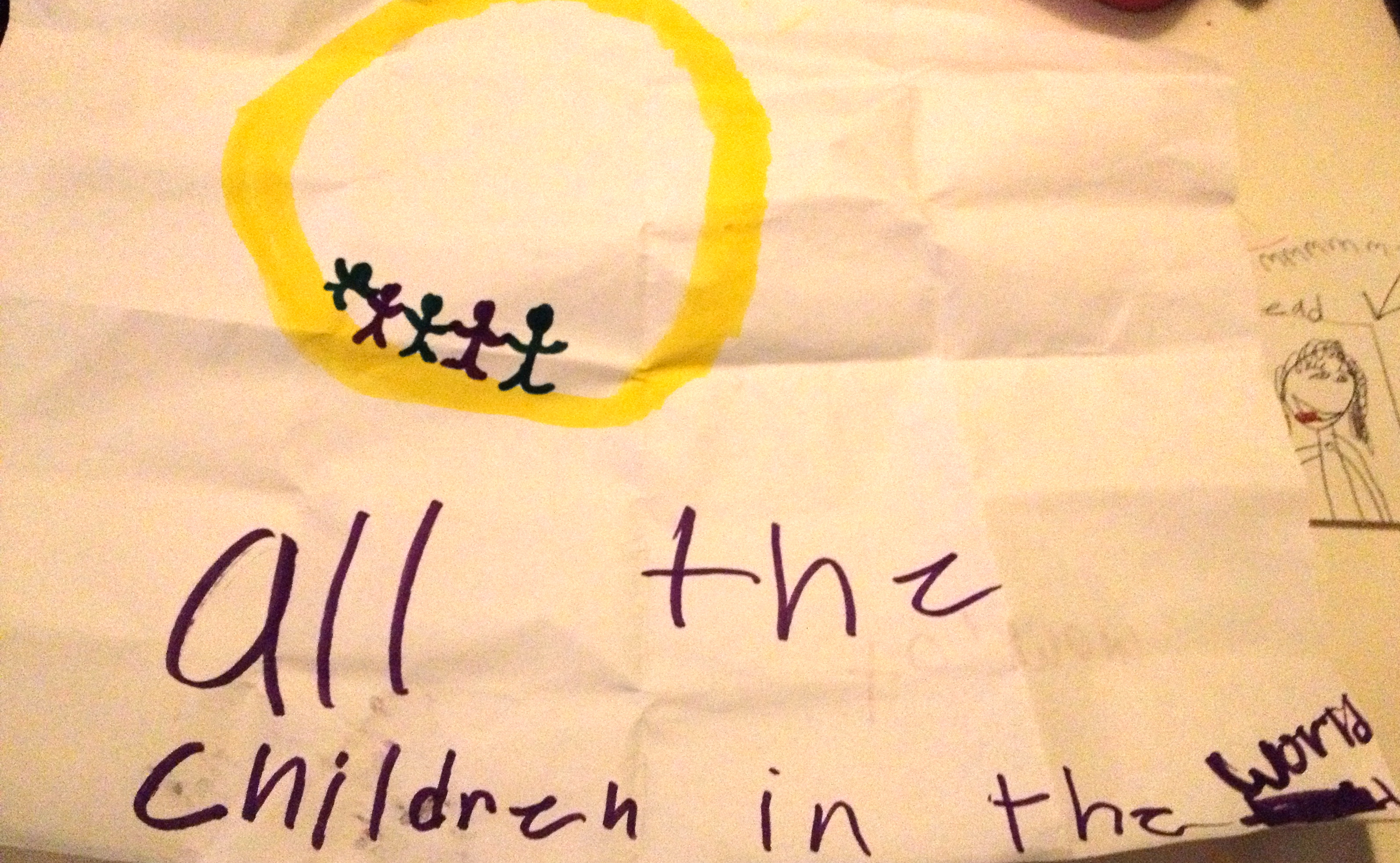
ADDITIONAL RESOURCES: You’re on your way to a great Human Rights Day! If you are a classroom teacher or homeschooling your kids (or if you just want to dig deeper), you can find tons more ideas through the following resources:
United Nations Cyber Schoolbus – human rights activities and information about the United Nations’ work
ABC – Teaching Human Rights – practical activities in English, French, Russian, Arabic, Chinese, and Spanish from the UN Office of the High Commissioner for Human Rights
The Advocates for Human Rights’ Discover Human Rights Institute – human rights education lesson plans and curriculum
Human Rights Here and Now – human rights lesson plans and resources
Raising Children With Roots, Rights and Responsibilities – activities for preschool and young elementary children
Do you plan to mark Human Rights Day with your kids?
This is an original post written for World Moms Blog by Jennifer prestholdt.

Jennifer Prestholdt is a lawyer and the Deputy Director of The Advocates for Human Rights, a volunteer-based human rights organization that works locally, nationally and internationally. Her work in human rights takes her around the world, but she spends most of her time in Minneapolis, MN, where she lives with her children (two sons and one daughter), her husband, an elderly cat and a dwarf hamster.
As Jennifer’s kids are now all in school (1st, 4th and 6th grades), she is finally finding more time to do the things that she used to love to do, especially running, writing and knitting. Jennifer loves to travel and has had the dubious distinction of having been accidentally locked in a bathroom on five continents so far. Australia and Antarctica await!
In January 2011, Jennifer made a New Year’s Resolution to start writing about her experiences in order to share with her children the lessons learned from 15 years of work in human rights. The result is her personal blog, The Human Rights Warrior. The name comes from her son Simon, who was extremely disappointed to learn that his mother is a lawyer, not a warrior.
You can find her on her blog The Human Rights Warrior or on Twitter @Jprestholdt.
More Posts

by Katinka | Dec 5, 2013 | 2013, Adoption, Adoptive Parents, Being Thankful, Belgium, Childhood, Cultural Differences, Culture, Education, Eye on Culture, Family, International, Kids, Life Lesson, Motherhood, Multicultural, Netherlands, Parenting, Penguin and Panther, Politics, Siblings, Traditions, Turkey, United Nations, World Events, World Motherhood, Younger Children
 As an adoptive mother of an Ethiopian Panther, I’ve grown an extra pair of antennas when it comes to racism.
As an adoptive mother of an Ethiopian Panther, I’ve grown an extra pair of antennas when it comes to racism.
Truly, a lot of really nice people distinguish my daughter from other children, based on her color. Even if it is meant to defend her, like calling me disgusting for letting her carry the groceries, it basically still is hidden racism. Should I tell her that people believe she shouldn’t be helping me out because it reminds them of slavery while her white brother is allowed to do the same chores? I’d rather have people call me names than let them wreck my daughter’s self esteem.
However, as I’m writing this, there is a HUGE racism debate going on in Belgium and even worse in The Netherlands, where it all started. And despite my racism antennas, I just can’t fully agree with the racism-yellers this time. Not even if they yell all the way from some United Nations office.
The debate is all about the ancestor of Santa Claus: Sinterklaas. You can read here about how Santa Claus evolved from our Sinterklaas, or Saint Nicholas, who is actually believed to be Turkish, who resides in Spain, has a white horse called Bad-Wheater-Today (Belgium) or Amerigo (The Netherlands), and celebrates his December birthday by coming over to our countries and surprising children with presents.
In the Netherlands he comes over on the evening of December 5th. Later that night, he comes to Belgium and delivers toys and sweets to be found in the children’s shoes on the morning of the 6th. It’s really a children’s celebration, full of magic and anticipation. You will bump into him just about everywhere during November.
Now, because Sinterklaas is getting old and forgetful, and has a lot of work to do within 24 hours, he has helpers. These helpers are all black, and hence all called ‘Black Peter’ (Zwarte Piet).
And that’s where all the accusative fingers point.
Indeed, this tradition can be seen as offensive. I, for a fact, believe it is partly based on a slavery and stereotype-loaded past, and a lot of people agree with me. Black Peter has long been depicted as a bit slow, barbaric (kidnapping and hitting the naughty children), dressed in clownish clothes, with stout lips and being submissive to his white boss.
Of course I agree this is an awful, insulting picture to brainwash our children with during the big Sinterklaas-Awaiting-Month-of -November. I also agree an outsider would be shocked, when he meets Sinterklaas and his Black Peters for the first time, especially if oblivious to the folklore. And I honestly understand and feel the offense people take.
For me personally, Sinterklaas has me cringing with bittersweetness ever since I found out about his racist taint. I’m not even particularly fond of the Sinterklaas tradition anymore.
However, I also don’t agree that we are teaching our children racism, nor paying ode to slavery by honoring this tradition every year. Not any more, that is.
Since the 1990’s, we have a children’s holiday special on TV portraying the real story. Children are elegantly taught Black Peter is black – and not brown/colored/african – because he came down the chimney. No more, no less. Nobody really tries to explain why his clothes didn’t get black during his journey down the chimney.
It is just part of the mystery, just like Bad-Wheater-Today walking on rooftops or Sinterklaas having this enormous book in which the good and bad behavior of every single child is listed. It doesn’t make sense, but children buy it anyway.
In this TV-special, Sinterklaas is depicted as a bit senile. In fact his Black Peters are now the smart ones, all with different names according to their function or character. A bit like the Smurfs, and everyone likes the Smurfs, right?
For the past 20+ years, this special comes on every November. Along the way, children started to grow more afraid of this very strict and grumpy old man than of his joyous, candy throwing helpers. The Black Peters became the true friends of our children. And every Belgian child you ask about Black Peter’s color now, will patiently tell you the chimney-story.
To me, this shows our tradition is evolving from, I admit, a racist past, towards a new story. Just like it evolved into Santa Claus overseas—who, by the way, appears to imprison a whole lot of innocent, little people in a Siberia-like, harsh environment without paying them for their round-the-clock labor.
Therefore, I trust society may even evolve towards a tradition of White Peters in a few more years or decades. After all, with more and more houses being built without huge chimneys, we will sooner or later find out that Peter’s color is fading, won’t we?
I’m hoping that by the time this post runs, all the petitions –pro and con–the social media frenzy, any UN investigations and any public manifestations, will be over and done with. I truly hope no-one got hurt along the way, and that both camps have reached a certain level of understanding towards each other by the time Saint Nicholas wants to celebrate his birthday.
Because, you know, my children are already expecting Sinterklaas to send one of his Peters down our chimney on the 6th of December. Especially my very dark daughter is impatiently awaiting. I’d hate to disappoint her if he decided not to come this year, because he’s afraid to be called a racist. She would definitely not understand, mainly because she doesn’t see any resemblance between Black Peter and herself.
I’m confident Sinterklaas will make it, though. We are both alike, Sinterklaas and me. We’re already used to people calling us racist slave handlers. And we both know better than that.
Did you know about Santa Claus’s European past? How would you feel if he had black helpers instead of elves?
This is an original post to World Moms Blog by K10K from The Penguin and The Panther.
The picture in this post is credited to Sinterklaas Himself, who published it on Wikipedia, while undercover as Gaby Kooiman, under GNU Free Documentation License.
If you ask her about her daytime job, Katinka will tell you all about the challenge of studying the fate of radioactive substances in the deep subsurface. Her most demanding and rewarding job however is raising four kids together with five other parents, each with their own quirks, wishes and (dis)abilities. As parenting and especially co-parenting involves a lot of letting go, she finds herself singing the theme song to Frozen over and over again, even when the kids are not even there...
More Posts

 Until a friend of mine had a terrible tragic accident in the Himalaya mountains that left her in a coma, I had never donated to a charity. We collected some money at our wedding to give to her husband, and my mom also donated some money to a charity that takes care of her, but that was it.
Until a friend of mine had a terrible tragic accident in the Himalaya mountains that left her in a coma, I had never donated to a charity. We collected some money at our wedding to give to her husband, and my mom also donated some money to a charity that takes care of her, but that was it.



















